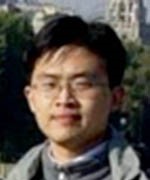
Professor
Email: [email protected]
Dr. Chen obtained his Ph.D. Degree from Institute of Neuroscience, Chinese Academy of Sciences in 2005. He was a research associate in the Department of Psychology at Vanderbilt University from 2005 to 2011. In March 2011, Dr. Chen joined Vanderbilt University Institute of Imaging Science as a faulty member. Dr. Chen joined Zhejiang Institute Interdisciplinary Institute of Neuroscience and Technology (ZIINT) in March 2014 as a Professor and the principle investigator of Vision Laboratory. He also serves as an Adjunct Instructor at Vanderbilt University. Dr. Chen’s research is focused on vision and, more specifically, the cortical mechanism of vision which involves studying how the visual system interprets visual information and produces the perception of vision. He employs various recording and imaging techniques to monitor and understand the function of the visual cortex across multiple scales, ranging from individual neurons to global inter-cortical neural networks. This includes high-density electrode array recording, multiple-modality optical imaging, and ultra-high field magnetic resonance imaging. Dr. Chen is also working on developing future generations of prosthetic neural implants for blind subjects to restore vision. He is a member of several scientific and professional societies, including International Society for Optics and Photonics (SPIE), Organization for Human Brain Mapping (OHBM), Society for Neuroscience (SFN), Vision Science Society (VSS). Dr. Chen has served as an expert reviewer on the grant panel for the East Asia and Pacific Summer Institute by the National Science Foundation (United States). He is also an ad hoc reviewer for many professional journals including Brain Research Bulletin, Neuroimage, Neuroscience Letters, Ophthalmic and Physiological Optics, Magnetic Resonance Imaging. His articles have been published in the Neuron, Neuroimage, Magnetic Resonance Imaging, Brain Stimulation, and Journal of Physiology, among other prestigious international journals. One of his articles was assigned as supplementary reading in a graduate course “Visual Neuroscience” taught at New York University. Review articles published in two major international review journals, Nature Reviews Neuroscience and Annual Review of Psychology have also featured Dr. Chen’s work. One of Dr. Chen’s papers was selected as a new finding by the “Faculty of 1000 Biology”, a website in which only the most important advances in biology are listed. In addition to article citations, Dr. Chen’s findings have been referred to in two textbooks (Adler’s Physiology of the Eye, 11th ed.; Normal Binocular Vision: Theory, Investigation and Practical Aspects) and two professional books on vision research (Perceiving in Depth; How Vision Works). Dr. Chen and his colleagues have also been invited to review their findings in a chapter titled “Functional architecture of area V2” in the Encyclopedia of Neuroscience, a comprehensive encyclopedia written by internationally known experts, and is thought to be the authoritative reference for the field of Neuroscience.
Research Interests:
- Cortical Mechanism of Vision
- Multiple-scale Brain Imaging
- Prosthetic Vision and Machine Vision
- Ultra-high Field MRI
Selected Publications:
1. Chen G, Dan Y, Li CY (2005) Stimulation of non-classical receptive field enhances orientation selectivity in the cat. J Physiol 564:233-243. (IF=4.380).
2. Cayce JM, Friedman RM, Chen G, Jansen ED, Mahadevan-Jansen A, Roe AW (2014) Infrared neural stimulation of primary visual cortex in non-human primates. Neuroimage 84:181-190. (IF=6.252).
3. Roe AW, Lu HD, Chen G (2009) Visual System: Functional architecture of Area V2. In: The Encyclopedia of Neuroscience (Squire L, ed), pp 331-349. Oxford, UK: Elsevier.
4. Lu HD, Chen G, Tanigawa H, Roe AW (2010) A motion direction map in macaque V2. Neuron 68:1002-1013. (IF=15.766).
5. Lu HD, Chen G, Ts'o DY, Roe AW (2009) A rapid topographic mapping and eye alignment method using optical imaging in Macaque visual cortex. Neuroimage 44:636-646.
< Back

